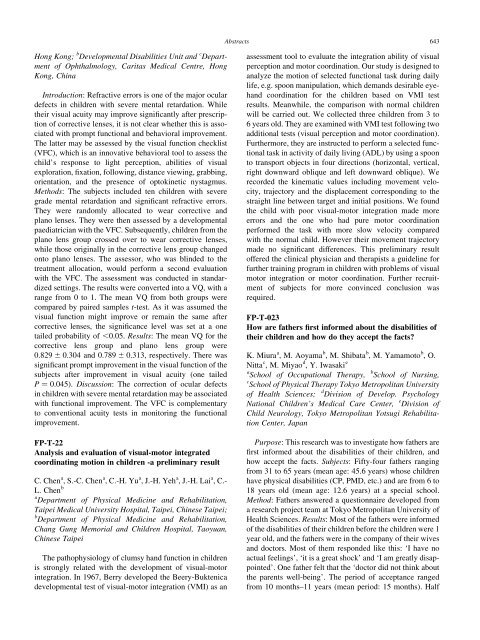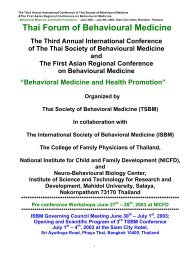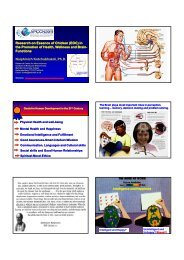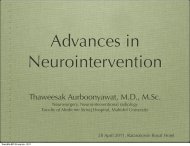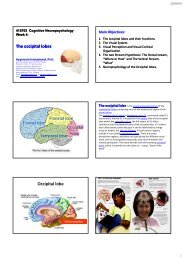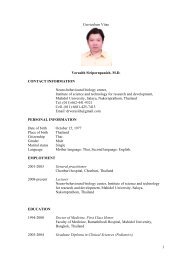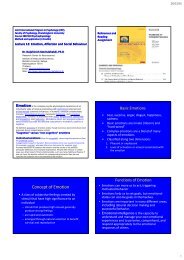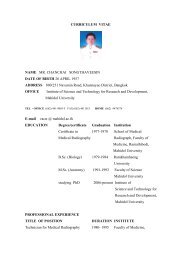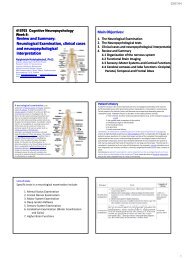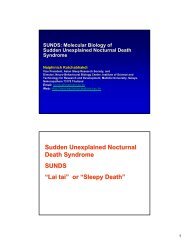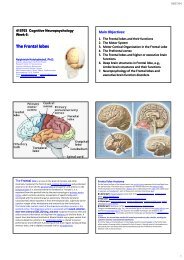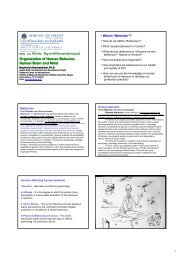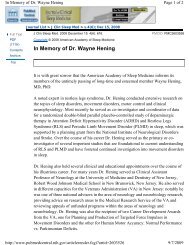PDF File - Mahidol University
PDF File - Mahidol University
PDF File - Mahidol University
You also want an ePaper? Increase the reach of your titles
YUMPU automatically turns print PDFs into web optimized ePapers that Google loves.
Abstracts 643<br />
Hong Kong; b Developmental Disabilities Unit and c Department<br />
of Ophthalmology, Caritas Medical Centre, Hong<br />
Kong, China<br />
Introduction: Refractive errors is one of the major ocular<br />
defects in children with severe mental retardation. While<br />
their visual acuity may improve significantly after prescription<br />
of corrective lenses, it is not clear whether this is associated<br />
with prompt functional and behavioral improvement.<br />
The latter may be assessed by the visual function checklist<br />
(VFC), which is an innovative behavioral tool to assess the<br />
child’s response to light perception, abilities of visual<br />
exploration, fixation, following, distance viewing, grabbing,<br />
orientation, and the presence of optokinetic nystagmus.<br />
Methods: The subjects included ten children with severe<br />
grade mental retardation and significant refractive errors.<br />
They were randomly allocated to wear corrective and<br />
plano lenses. They were then assessed by a developmental<br />
paediatrician with the VFC. Subsequently, children from the<br />
plano lens group crossed over to wear corrective lenses,<br />
while those originally in the corrective lens group changed<br />
onto plano lenses. The assessor, who was blinded to the<br />
treatment allocation, would perform a second evaluation<br />
with the VFC. The assessment was conducted in standardized<br />
settings. The results were converted into a VQ, with a<br />
range from 0 to 1. The mean VQ from both groups were<br />
compared by paired samples t-test. As it was assumed the<br />
visual function might improve or remain the same after<br />
corrective lenses, the significance level was set at a one<br />
tailed probability of ,0.05. Results: The mean VQ for the<br />
corrective lens group and plano lens group were<br />
0.829 ^ 0.304 and 0.789 ^ 0.313, respectively. There was<br />
significant prompt improvement in the visual function of the<br />
subjects after improvement in visual acuity (one tailed<br />
P ¼ 0:045). Discussion: The correction of ocular defects<br />
in children with severe mental retardation may be associated<br />
with functional improvement. The VFC is complementary<br />
to conventional acuity tests in monitoring the functional<br />
improvement.<br />
FP-T-22<br />
Analysis and evaluation of visual-motor integrated<br />
coordinating motion in children -a preliminary result<br />
C. Chen a , S.-C. Chen a , C.-H. Yu a , J.-H. Yeh a , J.-H. Lai a , C.-<br />
L. Chen b<br />
a Department of Physical Medicine and Rehabilitation,<br />
Taipei Medical <strong>University</strong> Hospital, Taipei, Chinese Taipei;<br />
b Department of Physical Medicine and Rehabilitation,<br />
Chang Gung Memorial and Children Hospital, Taoyuan,<br />
Chinese Taipei<br />
The pathophysiology of clumsy hand function in children<br />
is strongly related with the development of visual-motor<br />
integration. In 1967, Berry developed the Beery-Buktenica<br />
developmental test of visual-motor integration (VMI) as an<br />
assessment tool to evaluate the integration ability of visual<br />
perception and motor coordination. Our study is designed to<br />
analyze the motion of selected functional task during daily<br />
life, e.g. spoon manipulation, which demands desirable eyehand<br />
coordination for the children based on VMI test<br />
results. Meanwhile, the comparison with normal children<br />
will be carried out. We collected three children from 3 to<br />
6 years old. They are examined with VMI test following two<br />
additional tests (visual perception and motor coordination).<br />
Furthermore, they are instructed to perform a selected functional<br />
task in activity of daily living (ADL) by using a spoon<br />
to transport objects in four directions (horizontal, vertical,<br />
right downward oblique and left downward oblique). We<br />
recorded the kinematic values including movement velocity,<br />
trajectory and the displacement corresponding to the<br />
straight line between target and initial positions. We found<br />
the child with poor visual-motor integration made more<br />
errors and the one who had pure motor coordination<br />
performed the task with more slow velocity compared<br />
with the normal child. However their movement trajectory<br />
made no significant differences. This preliminary result<br />
offered the clinical physician and therapists a guideline for<br />
further training program in children with problems of visual<br />
motor integration or motor coordination. Further recruitment<br />
of subjects for more convinced conclusion was<br />
required.<br />
FP-T-023<br />
How are fathers first informed about the disabilities of<br />
their children and how do they accept the facts?<br />
K. Miura a , M. Aoyama b , M. Shibata b , M. Yamamoto b ,O.<br />
Nitta c , M. Miyao d , Y. Iwasaki e<br />
a School of Occupational Therapy,<br />
b School of Nursing,<br />
c School of Physical Therapy Tokyo Metropolitan <strong>University</strong><br />
of Health Sciences;<br />
d Division of Develop. Psychology<br />
National Children’s Medical Care Center,<br />
e Division of<br />
Child Neurology, Tokyo Metropolitan Yotsugi Rehabilitation<br />
Center, Japan<br />
Purpose: This research was to investigate how fathers are<br />
first informed about the disabilities of their children, and<br />
how accept the facts. Subjects: Fifty-four fathers ranging<br />
from 31 to 65 years (mean age: 45.6 years) whose children<br />
have physical disabilities (CP, PMD, etc.) and are from 6 to<br />
18 years old (mean age: 12.6 years) at a special school.<br />
Method: Fathers answered a questionnaire developed from<br />
a research project team at Tokyo Metropolitan <strong>University</strong> of<br />
Health Sciences. Results: Most of the fathers were informed<br />
of the disabilities of their children before the children were 1<br />
year old, and the fathers were in the company of their wives<br />
and doctors. Most of them responded like this: ‘I have no<br />
actual feelings’, ‘it is a great shock’ and ‘I am greatly disappointed’.<br />
One father felt that the ‘doctor did not think about<br />
the parents well-being’. The period of acceptance ranged<br />
from 10 months–11 years (mean period: 15 months). Half


